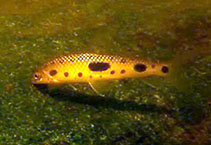| Diagnosis: |
Dorsal soft rays (total): 12-12; Anal soft rays: 9-10; Vertebrae: 38-39. Differs from all congeners except Leporinus cylindriformis, Leporinus niceforoi, Leporinus cf. niceforoi, Leporinus ortomaculatus, and a possibly undescribed species from the Amazon drainage (Leporinus sp.) by the combination of having an extremely dorsoventrally slender body (body depth immediately anterior to the dorsal-fin origin 18-23% in SL) and a pigmentation pattern including three or four large, black spots centred along the lateral-line-scale row. Can be separated from Leporinus niceforoi, Leporinus ortomaculatus, and Leporinus sp. by having six scales in a transverse series above the lateral line (in all but one examined specimen, which has five scales in that series) versus five scales in that series in all examined specimens of Leporinus niceforoi, Leporinus ortomaculatus, and Leporinus /i> sp.;
Leporinus cf. niceforoi by body depth 18.3-22.9% in SL versus 23.3-27.3% and by the typical transverse scale count at the dorsal and pelvic fin origins of 6/5 (5/5 and 6/4 each occur once) versus a typical count of 5/4 (occasionally 5/5, once 6/4, never 6/5); Leporinus cylindriformis and Leporinus niceforoi by the presence of a small, dark spot on the body immediately ventral to the seventh, eighth, or ninth scale of the lateral line, versus the absence of such a spot in those two species; and further Leporinus cylindriformis by the possession of a dark spot centered immediately posterior to the opercle and slightly ventral to the lateralline-scale row (versus the lack of such a spot), the presence of a series of nine to 14 dark bars across the dorsal surface of the body that terminate ventrally in darker areas that form an irregular stripe situated dorsal and parallel to the lateral line scale row (versus the lack of well-developed transverse bars and absence of such dark areas), and by body width 9.7-14.0% in SL (versus 15.2%) (Ref. 86822).
Description: Dorsal fin ii,10; anal fin ii,7-8; pectoral fin i,14-16; pelvic fin i,8 (Ref. 86822). |

